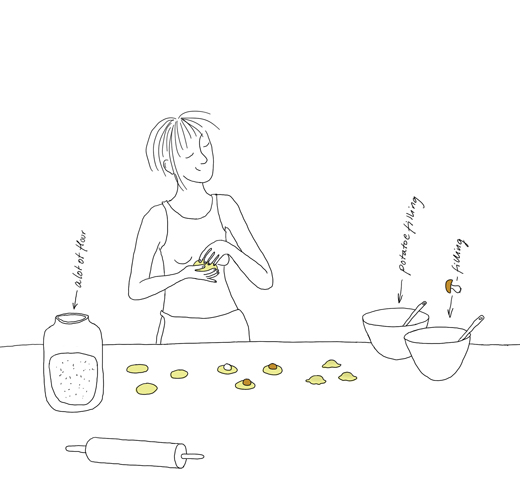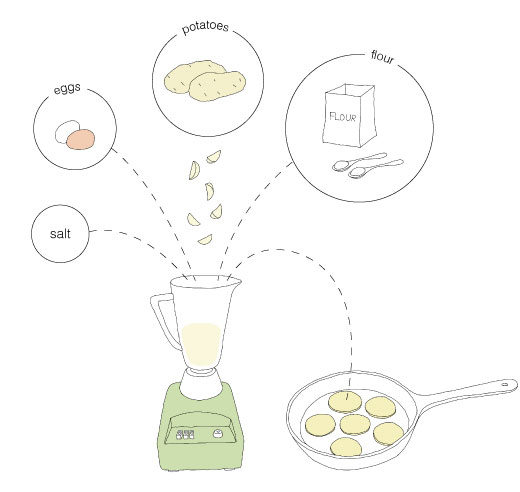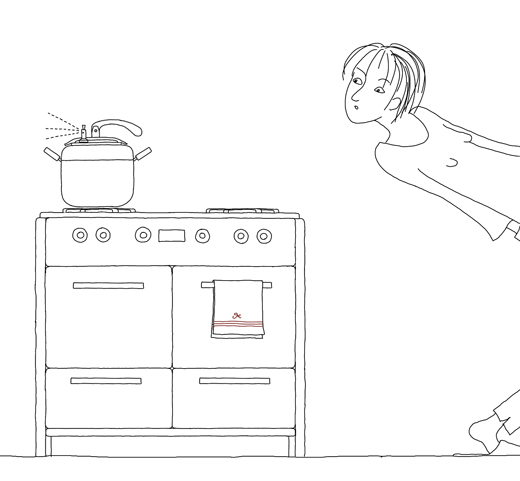
In Manhattan it’s hard to find great pierogi. I often find them too thick and heavy. Well M:s mother happens to be a great pierogi maker. She makes them so thin and light and fills them with sauerkraut and mushrooms, meat, or cheese and potatoes. I easily end up licking the plate. After all she is from Poland and as lovely as she is, she makes tons of them when we are around.
This summer I asked her for her dough secret. I was hoping to get the whole recipe written down, but her answer and recommendation was very short, “make them with warm water”!
dough (approximate 75 pierogi which serves about 6 people)
700 ml (3 cups) regular flour
1 whole egg
1 egg yolk (I used the egg white in the potatoes and cheese filling later)
1 tea spoon salt
175 ml (¾ cup) warm water (heated up, not directly from the tap)
Mix the flour and the salt together with the eggs. Heat up some water and mix small parts at a time into the flour mixture. I did it by hand but I think it works perfectly well to use a food processor. On a flat surface knead the dough until it’s firm and soft. Cover with a damp tablecloth and let it rest on the counter top while you are making the fillings.
mushroom filling
Here I made M:s Spicy Portobello Mushrooms. I used less water, as I didn’t want the filling to be too loose. Instead I used some cream to make it thicker.
cheese and potatoe filling
4 – 5 boiled potatoes
4 table spoons butter or olive oil
50 ml (0.2 cup) milk
1 egg white
about 120 ml (½ cup) farmers’ cheese
salt and pepper
cilantro
topping
melted butter
fine chopped and fried bacon
fine chopped and fried onions
Mash the potatoes with the egg white, some melted butter and milk. Add the farmers cheese as noted or to your own taste. Mix well and season with salt and pepper. Lastly add chopped cilantro. Note that cilantro is not really a traditional ingredient for a pierogi filling but I don’t think there are any strong rules on how to make fillings. You take what you have at home. I used a very mild type of cilantro. However many recipes seem to use fine chopped onions or chives. I will try garlic next time.
filling the pierogi
Uncover the dough and if necessary knead it some more. Divide into 4 pieces. Use lots and lots of flour while rolling one piece at the time to a 1/16” (1 mm) thickness. Make 3” circles and divide the fillings on top. Cover the filling and pinch the edges firmly to seal. Pat some more flower on every pirogi so they don’t stick together. If necessary add some more warm water to the dough as the flour makes it dryer in the process. Repeat until you have about 75 lovely pierogi.
Heat up salted water. When the water is boiling drop some of the pierogi in the water. When they are floating up to the surface let them boil approximate 1 minute more. Fish them out with a strainer. Top with melted butter and fried bacon and onions (chopped finely). Serve with a salad and some sour cream.
Well it is a long process… but luckily it was worth every minute. The pierogi ended up super thin and didn’t last very long.
There are many different versions on how to make pierogi. Some use sour cream and some use the egg yolk in their dough. My dough was inspired by several recipes but are quite similar to Kate Hopkins version.







